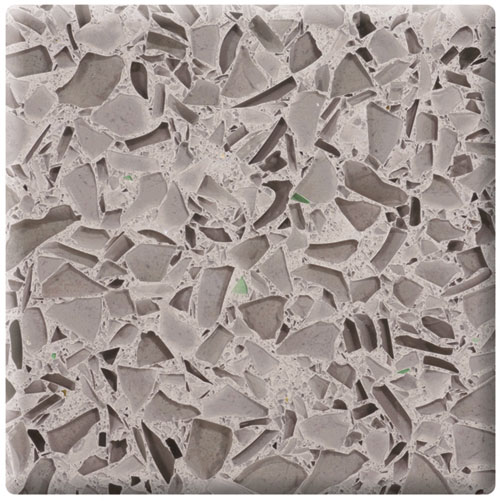Landfill Treasures: Recycling Glass from Trash to Upscale Interior Surfaces
CASE STUDY Los Angeles Townhouses Sander Architects, LLC approaches their residential design as an opportunity to find the metaphoric content created by the convergence of architect and client. They use design strategies that are not overt, but rather remain allusions, inspirations, reference points that inform the shaping and meaning of space. They have a pair of townhouses currently under construction that uses a recycled glass counter as one of many green design strategies that underscores the metaphors for this project. Facing one another over a drivable courtyard, these two 2100 and 2300 sf townhouses are like siblings—related but not identical. They both have three floors with generous living spaces and interior gardens that are open to above so that the core of each house is a green living space. Much of the extensive glazing will be a multi-wall translucent material often used in greenhouses in order to allow in light but retain privacy. The front house is on the street and so it orients outwards from the lot, with a two-car garage accessible directly from the street. Behind the garage, a “garden room” that can be used as a family room or den, will have large sliders that open the room to its own small exterior garden. The main communal living spaces are on the second floor, with the bedrooms on the third floor and access to a small roof garden. The rear house orients to a generous exterior garden on the rear of the house. The main living spaces on this level so that when the large sliders are open it creates a large indoor/outdoor living room. The second floor has a family room with a “balcony library”—the walkway surrounding the double-height space is lined with bookshelves. Bedrooms are on the third floor with access to a small roof garden. Green materials and strategies will include passive heating and cooling, natural daylighting, bamboo flooring, translucent acrylic glazing, kitchen cabinetry from FSC-certified wood, recycled glass countertops, low-flush toilets, and low VOC paint. Their client fell in love with a modern, recycled-glass slab with large pieces of dark grey glass embedded with tiny flecks of color. According to Catherine Holliss, her clients “love the fact that the countertops have a history: perhaps the glass comes from old traffic light lenses when they were switched to LED or perhaps from recycled bottles. All in all, it’s a win-win situation for the designer, the client and the planet.” The slab was purchased and stored for the client two years ago, as the project was slow to develop. Similar to purchasing other types of stone, marble or granite, the supplier maintains an inventory of slabs and may include storage as part of the sales price. The architect is currently designing to LEED® principles and hopes to certify this project. |
 |
Large pieces of clear flint glass with flecks of color add interest as well as contextual meaning to this piece of recycled glass surface. Photo courtesy of Polycor Vetrazzo Inc. |
Glass Transformed―Up-Cycling Waste Glass
Virgin glass making is energy intensive because of the energy required in the melting process. It begins as a mixture of:
- 70 to 75 percent sand
- 10 to 15 percent soda ash
- 10 to 15 percent limestone
- 5 percent cullet: furnace-ready recycled glass bits
The mixture is heated to a temperature of 2600 to 2800 degrees Fahrenheit and new glass is formed. Once glass is made, it maintains its properties almost indefinitely. Glass does not fade, retains color, is waterproof, and impervious to heat. Glass places between 6 and 7 on a scale of 1 to 10 on the Mohs scale, a standard measure of the scratch resistance of various minerals. Most glass that is recycled goes into other containers, but secondary uses include: countertops, flooring, landscaping, tile, decorative items, aggregates and roads. Some of these alternative uses require the use of additional energy, such as melting and reprocessing, to achieve a final product.
However, recycled glass surfaces can be manufactured without reheating or melting to achieve the new product. Recycling glass can save significant energy and reduce the carbon footprint in the manufacturing process.









